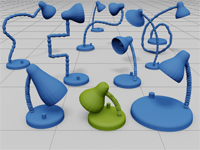
The creation of digital geometric content is one of the fundamental tasks in computer graphics and is indispensible in many areas of our life. Most man-made or manufactured objects around us, as well as man-made landscapes, are modeled on a computer first. Geometric modeling is essential in engineering design and simulation, product prototyping and manufacturing, surgical planning, prosthesis design, architecture, geology, art, films and video games, and more. With the advance of modern fabrication technology such as 3D printing, digitally modeled shapes are increasingly easy to realize as physical objects.

The goal of our research is to lay theoretical foundations for shape modeling and develop practical algorithms and systems for digital shape creation, editing and animation. We seak to make 3D modeling accessible and effective for a wide range of users. On the algorithmic side, we are interested in fast yet versatile and powerful modeling and editing approaches that should help artists and designers be more productive and creative. We also look into intuitive interfaces for modeling and animation that can be used by non-experts. Our objective is to make 3D geometry content as ubiquitous and widely accessible as digital images and videos are today.

Our work touches on various aspects of shape modeling and animation, both in research and education. Representative topics: physically-plausible shape editing, variational sketch-based modeling, skinning deformation and animation, geometry cloning, efficient and robust numerical methods for shape modeling, volumetric modeling, expressive nonrealistic modeling, fabrication-aware geometric modeling.
publications
Check out our publications page.
books
tutorials
- See our teaching page to get an overview of the classes offered on the topic of shape modeling
- Interactive Shape Modeling and Deformation, EUROGRAPHICS 2009 tutorial
- State-of-The-Art Report: Laplacian Mesh Processing, EUROGRAPHICS 2005 STAR